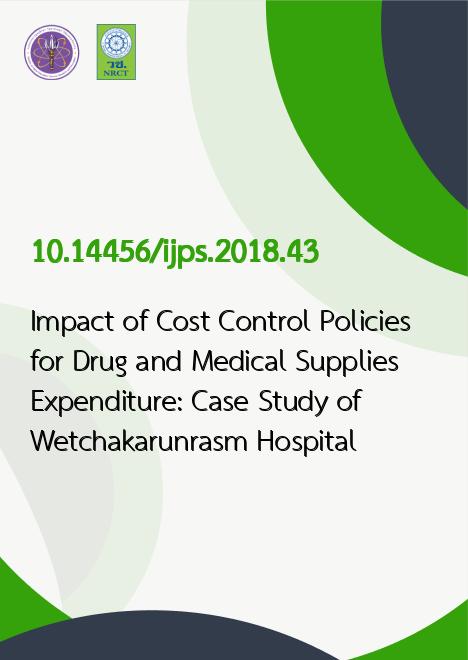
|
Impact of Cost Control Policies for Drug and Medical Supplies Expenditure: Case Study of Wetchakarunrasm Hospital |
|---|---|
| รหัสดีโอไอ | |
| Creator | Khobsoh Hasamoh |
| Title | Impact of Cost Control Policies for Drug and Medical Supplies Expenditure: Case Study of Wetchakarunrasm Hospital |
| Contributor | Nilawan Upakdee |
| Publisher | Faculty of Pharmaceutical Sciences KKU MSU UBU |
| Publication Year | 2561 |
| Journal Title | Isan Journal of Pharmaceutical Sciences |
| Journal Vol. | 14 |
| Journal No. | 4 |
| Page no. | 99-111 |
| Keyword | Cost control policies, Expenditure, Drug, Medical supplies |
| URL Website | https://tci-thaijo.org/index.php/IJPS |
| Website title | Isan Journal ofPharmaceutical Sciences, IJPS |
| ISSN | 19050852 |
| Abstract | Introduction: Due to the continued increase in drug and medical supplies expenditure, drug and medical supplies control policies have been implemented since the fiscal year 2017 at Wetchakarunrasm hospital. The cost control policies covered three domains including 1) price control policy; 2) quantity control policy; and 3) quantity and price control policy. This descriptive study aimed to assess the impact of cost control policies on drug and medical supplies expenditure. Methods: Drug and medical supplies expenditure during one year before (1 October 2015 30 September 2016) and one year after (1 October 2016 - 30 September 2017) implementation of cost control policies were explored. Changes in total drug and medical supplies expenditure were identified. Results:Implementation of drug and medical supplies control policies resulted in reducing drug expenditure by 15,015,951.75 bath (11.62 percent) and reducing medical supplies expenditure by 864,627.41 bath (17.51 percent). The top three drug control measures that highly potential to reduce the drug expenditure including negative list of non- essential drug (NED) and therapeutic substitution by essential drug (ED) and non-essential drug (NED) (reducing drug cost by 2,739,047.75 bath, 40.71 percent), limiting duplicate drug lists (reducing drug cost by 1,862,006.50 bath, 71.68 percent) and purchasing generic drugs with lower price ( reducing drug cost by 456,966 bath, 5.12 percent), respectively. Conclusion: The drug and medical supplies control policies help to reduce hospital expenditure. |
